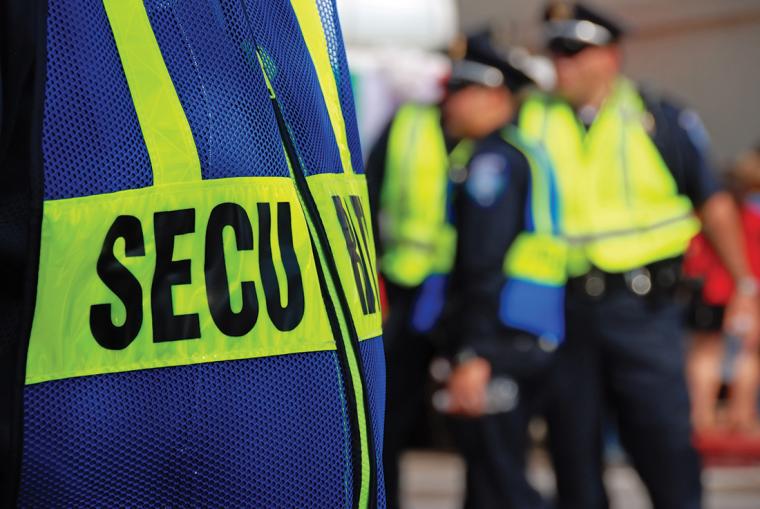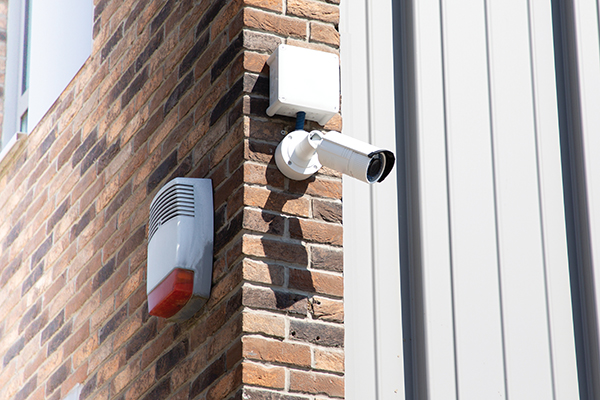
Sporting events are America’s favorite pastime. Hundreds of thousands of fans flock to watch their favorite teams battle it out on the playing field. These spectators expect and demand safe and secure events. Venue directors must plan and prepare for all hazards by assessing risks and preparing for threats that may cause harm to all stakeholders. Common threats such as inappropriate fan behavior, crowd density, extreme weather and rogue drones should be addressed periodically with staff.
Inappropriate fan behavior is a top concern for security managers. The National Center for Spectator Sports Safety and Security (NCS4) 2022 Venue Security Director Industry Report stated that the majority of event security directors (65 percent) mentioned inappropriate fan behavior was worse than 10 years ago, with the majority of behavioral issues occurring due to alcohol abuse and fights between patrons. Examples of inappropriate behavior have been reported from youth sports to professional sports and documented at multiple sporting events such as youth baseball, high school basketball, college football, professional baseball and professional football.

Recommendations to combat these issues include staff training in identifying substance abuse, strict adherence to alcohol policies, strategic placement of security staff and appropriate penalties for violations of these policies. Penalties may include immediate ejection from the event, expulsions from future games, loss of season tickets, fines and potential arrest/prosecution. Some leagues may additionally require violators of the fan code of conduct to submit a written request for readmission to an event and complete an online fan code of conduct training course in consideration for future attendance.
Regarding crowd management, recent trends of social influencers attending events unexpectedly have posed challenges to security managers. Influencers may post a thread to their social media account about a “promotional giveaway” at an event or an impromptu appearance, which in turn causes an instant congregation of their fans around the perimeter of the facility. Proper preparation in crowd management is necessary to handle the influx of the influencer’s fan base along with thousands of event spectators.
LSU gymnastics star and social influencer Olivia Dunne created a stir at a gymnastics event at the University of Utah, which caused LSU to bolster its security detail at home events. Twitch influencer Kai Cenat started a riot among followers when he hosted a giveaway event in Manhattan’s Union Square.
Once notified, venue directors must be prepared to deploy trained staff to areas of concern. Crowd control measures must consider parking and traffic flow, ingress and egress, rowdy spectators, illegal entry, etc. Prevention methods include monitoring social media accounts, staff training, communication, barriers and adequate personnel.
Weather issues such as extreme heat and lightning have recently caused problems across the country. The National Weather Service reports that heat-related illnesses are the leading weather-related killers in the U.S., causing over 1,000 fatalities each year. Approximately 30 people are killed every year by lightning, with hundreds more injured. To combat weather-related incidents, venues must ensure effective communication with spectators on policies and procedures for various types of weather-related incidents.
Specified locations should be identified for evacuation purposes, with heating, cooling and/or watering stations available depending on the forecast for the event. Venues should communicate extreme weather protocol through various platforms such as P.A. announcements, venue signage, social media, emails and mobile applications.
The popularity of unmanned aerial vehicles (UAVs), better known as drones, has caused a notable increase in concern from security directors due to potential attacks. Many drone users have no ill intent when flying their drones; however, due to the recent usage of drones in warfare and by terrorist groups, venue directors must remain vigilant.
Unfortunately, drones have the potential to be armed with weapons such as guns, bombs, or even biological or chemical substances. Suspicious drones could instill fear in a large crowd, causing mass hysteria, which could lead to multiple injuries from panicked spectators. Prevention methods include drone detection technology, which detect, classify, locate/track and alert. Countermeasures may include destroying the drone, neutralizing the drone or taking control of the drone; if an event is likely to attract unsanctioned UAVs, organizers should have personnel trained in these countermeasures.

Preparations for other threats such as terrorist attacks, active shooters, bombing, vehicular ramming and cyber security are also necessary due to the severity and ramifications of the impact this has on the community. Venues are using various technologies to combat these threats. Some emerging technologies include walk-through scanners, biometric entry, enhanced surveillance cameras with weapon detection capabilities and retractable bollards.
Walk-through scanners reduce wait time in the screening process by allowing spectators to enter the facility without stopping for a bag search or a non-prohibited item. These scanners can detect potential weapons brought in by patrons and alert staff of the threat’s exact location via photo for a more in-depth search.
Biometric entry is another emerging technology that a few teams have piloted to reduce wait times and eliminate the number of fake credentials. This software system ensures that only credentialed personnel have access to certain areas in the stadium. Enhanced surveillance cameras can detect potential weapons and track the location of the possible threat, allowing staff to intercept and detain.
Gunshot detection software is also available, which uses sound acoustics to distinguish between actual gunshots and similar sounds, such as vehicular backfires and fireworks. In terms of mitigating bombing threats, many facilities deploy explosive detection canines, whereas some facilities utilize explosive particle detectors.
According to NCS4’s 2022 Venue Security Director Industry Report, most professional venues are using stationary bollards as a barrier to protect against vehicle ramming. However, retractable bollards and automated barrier systems are gaining traction as the most desired systems to protect against vehicular ramming.
Cyber security issues also emerge as a threat as criminals target sports organizations primarily for financial gain. Perpetrators use multiple methods to hack the venue network infrastructure to gain access to valuable data or maliciously act on an organization or person. There have been data breaches in professional sports organizations, including the theft of personal information of players and their families, the robbery of contracts and financial data, and a ransomware attack that disrupted network systems.
In 2019, a cyber breach occurred at an online store for a professional sports team in which hackers stole customer payment data. Some precautions venues should consider include educating employees in basic cyber hygiene training, periodic monitoring and auditing of organizational social media accounts – and, of course, ensuring the latest software updates are installed.
Other emerging trends and technologies include enhancing the fan experience by reducing wait times, enhancing shopping processes and providing accommodations for patrons with access and functional needs. Many professional venues have completely transitioned to cashless point-of-sale locations, with most venues offering frictionless checkout experiences.
Venues looking to enhance security measures through technological solutions should examine operational needs by reviewing operational environment assessments, analyzing recent risk assessments and evaluating key performance indicators (KPIs) before making any changes. This exercise may dictate that operational requirements are best met through thoughtful planning, appropriate training and updated policies and procedures.
However, if technological solutions are necessary for increased productivity and efficiency, venues should consult other organizations with similar stakeholders to ensure those solutions are meeting desired goals with appropriate outcomes. Several solution providers should be contacted before making a final decision. Factors to consider include the cost of deployment, recurring licensing requirements, training materials, independent review and certifications. Venues may seek providers that offer a trial period. This would allow venues to review the product and assist in determining the potential return on investment for the solution.
There are multiple organizations, associations and research centers where event and security directors can glean valuable information. Resources such as the National Center for Spectator Sports Safety and Security, Department of Homeland Security, Cybersecurity and Infrastructure Security Agency, International Association of Venue Managers, Event Safety Alliances, Security Industry Association and ASIS International provide additional tools and training for stakeholders to mitigate emerging threats and allow spectators to enjoy the event without concern for their safety. SDM


